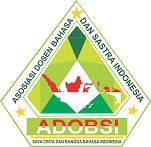AFIKS DERIVASIONAL BER- PADA MEDIA MASSA INDONESIA
DOI:
https://doi.org/10.21776/ub.hastawiyata.2021.004.02.01Keywords:
derivational affix ber, news, mass mediaAbstract
News is part of the mass media that is easily accessible to all people. News has the characteristics of language is short, concise and objective. The use of language in writing news must pay attention to the writing of word structures, word formation in accordance with PUEBI. One of the word formation that occurs is the result of affixation process. One of the productive affixes in Indonesian is the prefix ber-. This study discusses the derivational affixes contained in mass media coverage in Indonesia. Data sources came from national, regional, and local online mass media during the period of September 2020. Data were obtained using observation methods and note-taking techniques. Data were analyzed using the split method with direct element sharing techniques. The use of the affix on the Indonesian mass media in the form of Ber+N= V has the meaning (1) in the state; (2) obtain, produce; (3) have; and (4) reflexive. Whereas Ber+A= V means 'in a state'. Ber+Adv.= V means 'in a state'. Ber+N= Num. has the meaning of 'collection / collective', and Ber+bound morpheme= V has the meaning (1) 'in a state'; (2) 'have'. Variations in the use of affixes are mostly carried out in the national media and the affixes of ber- which are not yet available in the Kridalaksana book are Ber+Adv.= V, Ber+N= Num. , and Ber+bound morpheme= V.
References
Ayuningtyas, Daisy. 2016. Penggunaan Afiks Ber-An Dalam Surat Kabar Kompas. Skripsi. Fakultas Ilmu Budaya. Universitas Negeri Jakarta.
Bagiya. 2017. Infelksi dan Derivasi dalam bahasa Indonesia. Journal Uhamka. 1(1): 32-40.
Chaer, Abdul. 2007. Linguistik Umum. Jakarta: Rineka Cipta.
Gita, Raden. 2014. Analisis Fungsi dan Makna Afiks Ber- dalam Bahasa Indonesia. https://www.academia.edu/8293300/Analisis_Fungsi_dan_Makna_Afiks_Ber_dalam_Bahasa_Indonesia (diakses 19 Oktober 2020)
Kridalaksana, H. 2009. Pembentukan Kata Dalam Bahasa Indonesia. Edisi 5, PT Gramedia Pustaka. Jakarta-Indonesia.
Luckiyanti, R. 2015. Analisis Fungsi Dan Makna Afiks Pada Judul Berita Surat Kabar Jawa Pos Edisi Oktober 2014. Fakultas Keguruan dan Ilmu Pendidikan Universitas Muhammadiyah, Surakarta.
Mahsun. 2014. Metode Penelitian Bahasa: Tahapan Strategis, Metode, dan Tekniknya. Depok: PT Rajagrafindo Persada.
Purnanto,Dwi. 2006. Kajian Morfologi Derivasional Dan Infleksional Dalam Bahasa Indonesia. Jurnal UMS. 18 (2): 1-16.
Ramlan, M. 2012. Morfologi: Suatu Tinjauan Deskriptif. Edisi 14, CV Karyono. Yogyakarta-Indonesia.
Ramza, H dkk. 2013. Analisis Hubungan Imbuhan Me dan Ber pada setiap Perenggan dalam Tulisan Cerita Pendek “Kembali Kasihâ€. Jurnal Matematika Terapan Indonesia. 1 (1): 1-12.
Sudaryanto. 1993. Metode dan Aneka Teknik Analisis Bahasa. Yogyakarta: Duta Wacana University Press.
Sutedi, Dedi (2008). Dasar-dasar Linguistik Bahasa Jepang. Bandung: Humaniora.
Tustiantina, Diana. 2016. Mencermati Bentuk Infleksi dan Derivasi dalam Bahasa Indonesia. Jurnal Membaca. 1 (1): 21-31.














